The Borough of Manhattan Community College (BMCC) is a public community college in New York City. Founded in 1963 as part of the City University of New York (CUNY) system, BMCC grants associate degrees in a wide variety of vocational, business, health, science, engineering and continuing education fields.
Columbia University in New York City has an extensive tunnel system underneath its Morningside Heights campus connecting many of its buildings, used by the university as conduits for steam, electricity, telecommunications, and other infrastructure. Throughout their history, the tunnels have also been used for other purposes, mostly centering around transportation. During the first half of the 20th century, they were used by students to avoid aboveground traffic. When the university housed the Manhattan Project, they were allegedly used to move radioactive material between buildings. During the Columbia University protests of 1968, students used the tunnels to facilitate their occupation of buildings on campus.
Yeshiva College is located in New York City’s Washington Heights neighborhood in Upper Manhattan. It is Yeshiva University’s undergraduate college of liberal arts and sciences for men. The architecture reflects a search for a distinctly Jewish style appropriate to American academia.

John Jay Hall is a 15-story building located on the southeastern extremity of the Morningside Heights campus of Columbia University in New York City, on the northwestern corner of 114th St. and Amsterdam Avenue. Named for Founding Father, The Federalist Papers author, diplomat, and first Chief Justice of the United States Supreme Court John Jay, it was among the last buildings designed by the architectural firm of McKim, Mead & White, which had provided Columbia's original Morningside Heights campus plan, and was finished in 1927.
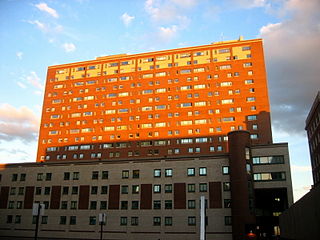
East Campus is a prominent building on the Morningside Heights campus of Columbia University in New York City, located along Morningside Drive between 117th and 118th Streets. One of the tallest buildings in the neighborhood, it serves primarily as a residence hall for Columbia undergraduates, although it also contains a small hotel, the university's Center for Career Education, its Facilities Management office, and the Heyman Center for the Humanities. East Campus, a $28.7 million facility, was designed by Gwathmey Siegel & Associates Architects and built in 1979-1982.
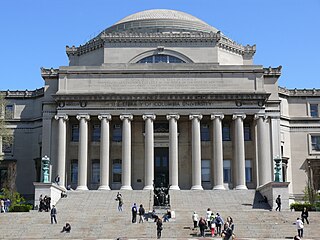
The Low Memorial Library is a building at the center of Columbia University's Morningside Heights campus in Upper Manhattan, New York City, New York, United States. The building, located near 116th Street between Broadway and Amsterdam Avenue, was designed by Charles Follen McKim of the firm McKim, Mead & White. The building was constructed between 1895 and 1897 as the university's central library, although it has contained the university's central administrative offices since 1934. Columbia University president Seth Low funded the building with $1 million and named the edifice in memory of his father, Abiel Abbot Low. Low's facade and interior are New York City designated landmarks, and the building is also designated as a National Historic Landmark.

Hartley Hall was the first official residence hall constructed on the campus of Columbia University's Morningside Heights campus, and houses undergraduate students from Columbia College as well as the Fu Foundation School of Engineering and Applied Science. The building is named for Columbia alumnus Marcellus Hartley Dodge, who donated $300,000 for its construction shortly after his graduation. The building was meant as a memorial to his grandfather, Marcellus Hartley, the owner of Remington Arms, who died during Dodge's sophomore year and who bequeathed him the family fortune. Dodge hoped to create “the commencement of a true dormitory system" at Columbia.

Wallach Hall is the second oldest residence hall on the campus of Columbia University, and currently houses undergraduate students from Columbia College as well as the Fu Foundation School of Engineering and Applied Science. It opened in 1905 as "Livingston Hall" after Robert Livingston, a Founding Father of the United States and alumnus of King's College, Columbia's predecessor, but its name was changed after Ira D. Wallach donated approximately $2 million towards its renovation. This gave rise to the joke, "Livingston signed the Declaration of Independence, Wallach signed a check."

Hogan Hall is a dormitory of Columbia University primarily reserved for fourth-year undergraduate students. The dorm is popular for its suite configurations as well as its central location. Built in 1898 as a nursing home, the building was converted to graduate student housing in 1977. It was named after Frank S. Hogan. It was converted into an undergraduate residence in 1994, then renovated in 2000 with the completion of a new entrance connecting it to Broadway Hall, designed by Robert A.M. Stern Architects. Located at the corner of 114th Street and Broadway in the Manhattan neighborhood of Morningside Heights, the building is named for former New York District Attorney Frank Hogan.
Broadway Residence Hall is a postmodern dormitory at Columbia University in New York City. The building is commonly referred to by students as "Broadway". The building is nominally located at the corner of Broadway and 113th Street, though it shares its main entrance, which opens onto 114th Street, with Hogan Hall. Designed by Robert A.M. Stern Architects, it opened in 2000. Originally supposed to blend with the redbrick McKim, Mead & White buildings of the Columbia campus, Broadway Hall's design was changed to placate neighbors who wished to see it blend with local apartment buildings. In addition to housing students, its lower levels are home to a hardware store and a branch of the New York Public Library system.
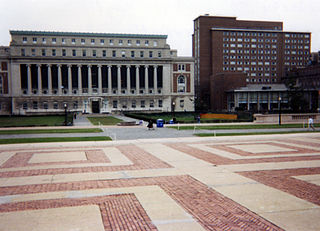
Carman Hall is a dormitory located on Columbia University's Morningside Heights campus and currently houses first-year students from Columbia College as well as the Fu Foundation School of Engineering and Applied Science.

Columbia University has developed many traditions over its 269-year-long existence, most of them associated with its oldest undergraduate division, Columbia College.
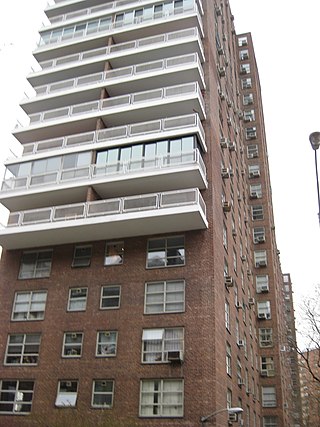
Morningside Gardens is a private housing cooperative operated by Morningside Heights Housing Corporation (MHHC) in Morningside Heights, Manhattan, New York City. It is composed of a parking garage and six apartment buildings of 21 stories each, for a total of about 980 apartments. MHHC rents space to the Children's Learning Center preschool and the Morningside Retirement and Health Service. The complex has many amenities for its cooperators including a playground, a fitness center, storage units, indoor play spaces for children and young adults, bike rooms, and a workshop including ceramics and woodworking.

Morris Abraham Schapiro was an American investment banker and chess master; in the 1950s, he negotiated the mergers of Chase Bank and the Bank of Manhattan and of Chemical Bank and New York Trust Company. His brother was art historian Meyer Schapiro.

Claremont Avenue is a short avenue in the Morningside Heights neighborhood of Manhattan, New York City. It begins at 116th Street and runs north for a length of eleven blocks until it ends at Tiemann Place.

Patrick Radden Keefe is an American writer and investigative journalist. He is the author of five books—Chatter,The Snakehead,Say Nothing,Empire of Pain, and Rogues—and has written extensively for many publications, including The New Yorker, Slate, and The New York Times Magazine. He is a staff writer at The New Yorker.
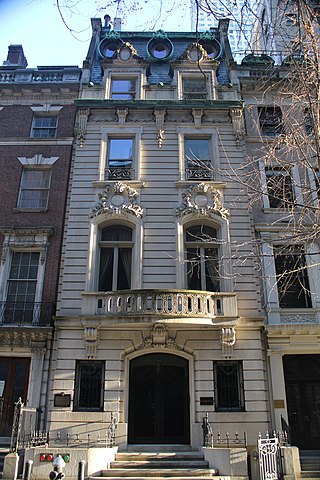
7 West 54th Street is a commercial building in the Midtown Manhattan neighborhood of New York City. It is along 54th Street's northern sidewalk between Fifth Avenue and Sixth Avenue. The four-story building was designed by John H. Duncan in the French Beaux-Arts style and was constructed between 1899 and 1900 as a private residence. It is one of five consecutive townhouses erected along the same city block during the 1890s, the others being 5, 11, and 13 and 15 West 54th Street.

30 West 56th Street is a building in the Midtown Manhattan neighborhood of New York City. It is along 56th Street's southern sidewalk between Fifth Avenue and Sixth Avenue. The five-story building was designed by C. P. H. Gilbert in the French Renaissance Revival style. It was constructed between 1899 and 1901 as a private residence, one of several on 56th Street's "Bankers' Row".

Buell Hall is an academic building on the Morningside Heights campus of Columbia University in New York City. Built in 1885 as Macy Villa, it is the oldest building on Columbia's campus, and the last remaining building at Columbia which dates back to the Bloomingdale Insane Asylum, on whose grounds the university is now located. It now houses La Maison Française, the oldest French cultural center on an American university campus, as well as the Temple Hoyne Buell Center for the Study of American Architecture of the Columbia Graduate School of Architecture, Planning and Preservation.
Rat Rock is an outcrop of Manhattan schist between 600 and 604 West 114th Street in the Morningside Heights neighborhood of Manhattan, New York City. The boulder measures approximately 30 feet (9.1 m) high and 100 feet (30 m) long; it is notable as one of the only remaining such rocks remaining in Manhattan's street grid. It was named Rat Rock for the large number of rats nesting in it, similar to the other Rat Rock in Central Park. The row houses around it were built in the 1890s, when land in Manhattan was significantly less valuable. Though the land on which it sits has greatly appreciated in value, Columbia University, which owns Rat Rock along with most of West 114th Street, has no plans to remove it, as it has been estimated that removing the rock could cost hundreds of thousands of dollars. The fence around it was placed by the university in order to prevent vandalism. Columbia professor Andrew Dolkart described it as "an extraordinary survivor" of New York City's development, because it "hints at the geology of the city", and The New York Times labelled it one of New York's "most amazing natural wonders".

















